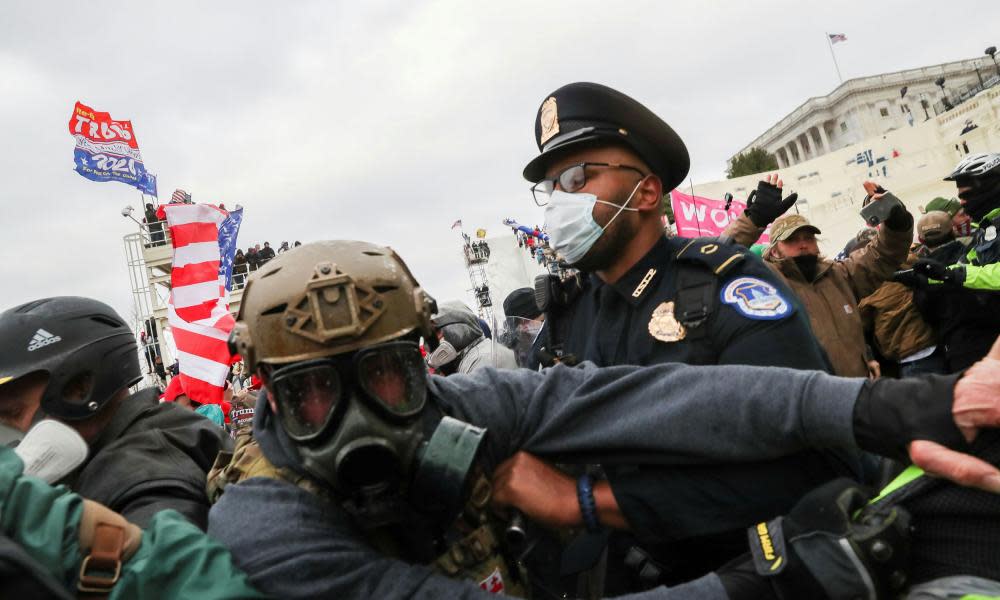Capitol attack: what Pelosi’s select committee is likely to investigate

- Oops!Something went wrong.Please try again later.
Nancy Pelosi’s creation of a House select committee to investigate the 6 January insurrection reopens the possibility of a comprehensive inquiry into myriad security failures and the causes of the deadly attack on Congress by a pro-Trump mob.
Related: Nancy Pelosi signals hard line on formation of 6 January select committee
The committee will have subpoena power and a broad mandate to examine the facts, circumstances and causes of the Capitol attack against the seat of modern American democracy.
The move comes after Senate Republicans blocked the creation of a 9/11-style commission to investigate the Capitol attack, fearful of scrutiny that could tarnish their party ahead of the 2022 midterm elections.
Now, six months after the attack, here are the key issues that the committee may look at:
What were Trump and members of his administration doing during the attack?
At some point after he delivered his incendiary speech to thousands of supporters opposite the White House, the former president watched TV coverage of the unfolding insurrection from the Oval Office.
Trump also knew that the rioters had breached the Capitol since he was told in real time over the phone by Republican senator Tommy Tuberville that his colleagues were being evacuated from the chamber.
Yet the former president appeared to do nothing to call off the rioters – almost exclusively his own supporters. Nor did he act later when he was begged to do so by House minority leader Kevin McCarthy.
In conflicting accounts, Trump later claimed he called in the national guard, but his acting defense secretary Christopher Miller later testified that he never spoke to the former president during the entire day.
Why were police and US intelligence agencies so unprepared?
At a Senate hearing in the weeks after the insurrection, the former US Capitol police chief Steven Sund, former House sergeant-at-arms Paul Irving, and his Senate counterpart, Michael Stenger, deflected and laid the blame at each other.
The convoluted accounts of the three top officials illustrated the chaos of the day as well as the difficulty of now untangling testimony, which differed from police chief to police chief, as they sought to quell the riot.
The officials also blamed the FBI and the US intelligence community for failing to provide adequate warnings that rioters planned to seize the Capitol, and criticized the Pentagon for moving too slowly to authorize the national guard.
Yet the initial part of their complaints was contradicted by revelations that an FBI field office in Virginia issued an explicit warning that extremists were preparing to travel to Washington to commit violence a day before 6 January.
Why did it take hours for the national guard to be deployed?
The commander of the DC national guard at the time, Maj Gen William Walker, has said that he did not receive approval to mobilize troops until more than three hours after he first made the request.
Defense department and Capitol security officials have given conflicting statements to explain the delay as well as an unusually restrictive command policy that appeared to come directly from the Trump White House.
Walker said he was unable to move troops even from one traffic stop to another without permission from then army secretary Ryan McCarthy, he testified.
He added he was uncertain why the restrictions were in place specifically, but raised the prospect that “army senior leaders did not think it looked good” and sending troops in to subdue Trump supporters would not be a “good optic”.
Was there any coordination between Trump White House officials, Republican lawmakers and the rioters?
An organizer of the “Stop the Steal” rally, Jim Arroyo, who also leads the Arizona chapter of the rightwing Oath Keepers militia group, has previously said that three members of Congress “schemed up” the events of 6 January with him.
House Republican and longtime Trump ally Paul Gosar was certainly among the lawmakers who participated in the rally that immediately preceded the Capitol attack, though he has denied any involvement with the insurrection.
The DoJ is also investigating whether a number of House Republicans provided tours of the Capitol and other information about the Capitol complex to people who might have gone on to be part of the Trump mob.

